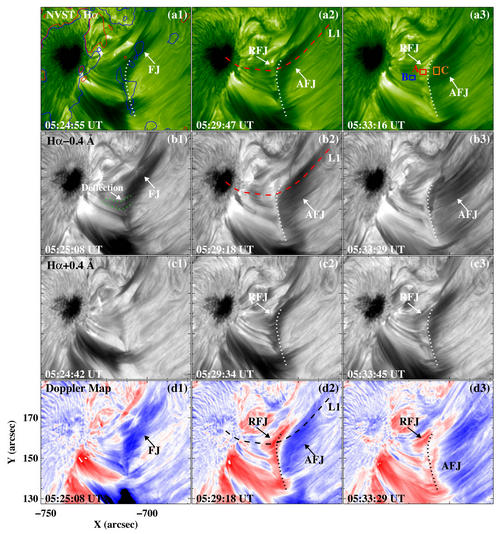Using high-quality Hα observations from the New Vacuum Solar Telescope (NVST), Dr. Ting Li from National Astronomical Observatories of Chinese Academy of Sciences (NAOC) and other partners first report apparent fan-shaped jets generated during the interaction between primary fan-shaped jets and nearby facula magnetic structure. The result was published in the Monthly Notices of the Royal Astronomical Society.
"Recent high spatial- and temporal-resolution observations have revealed various types of jets in the chromosphere, such as anemone jets, penumbral micro jets and fan-shaped jets. Chromospheric fan-shaped jets have raised lots of concerns in recent years, and they are chromospheric material injecting up to corona along a series of magnetic structures arranged in order. Unlike the ubiquitous coronal jets, chromospheric fan-shaped jets are usually observed above the sunspot light bridge and the penumbra. In some observations, the footpoints of chromospheric fan-shaped jets are associated with impulsive heating and coincide with strong electric current, suggesting that the driver of this kind of jet is magnetic reconnection in the lower atmosphere." said Dr. Ting Li.
Until now, many questions about the fan-shaped jets are still unknown. What is the generation mechanism of fan-shaped jets? What is the interaction process between jet material and other magnetic structures? Can the fan-shaped jets heat the chromosphere and corona? Dr. Ting Li focused on these unresolved questions and carried out the related research works.
Based on high-quality data from the NVST in China, they first report collision-induced apparent fan-shaped jets. While the propagating primary fan-shaped jet launched from a sunspot penumbra encountered and collided with the magnetic structure of the nearby facula, it evolved into two parts, with one part being reflected away from the facula and the other part forming an apparent fan-shaped jet. Easily distinguished from the primary fan-shaped jet, the ejecting fan-shaped jet was more ordered and had an apparent end at the facula. The observed apparent fan-shaped jet had a similar morphology to the quasi-separatrix layer (QSL) between the penumbra and facula magnetic systems, implying that the material of the apparent fan-shaped jet was mainly guided by the fan plane of the QSL.
"Solar chromosphere is the media of interchanging the material and energy between the photosphere and corona, and the study of solar chromosphereis important to understand the chromospheric and coronal heating. The study about the interaction process between jet material and other magnetic structures can help to reveal the 3Dmagnetic configuration nearby sunspots." said Dr. Ting Li.

Figure. Upper: NVST Hα line-centre images; Two rows in the middle: Hα-0.4 ? images and Hα+0.4 ? images; Below: constructed Doppler maps.FJ, AFJ and RFJ are respectively primary, apparent and reflected fan-shaped jets. (Credit: Ting Li)
This paper can be accessed at https://academic.oup.com/mnras/article/492/2/2510/5709064

Address: 20A Datun Road, Chaoyang District, Beijing, China code: 100012
Tel: 010-64888708 E-mail: naoc@nao.cas.cn

